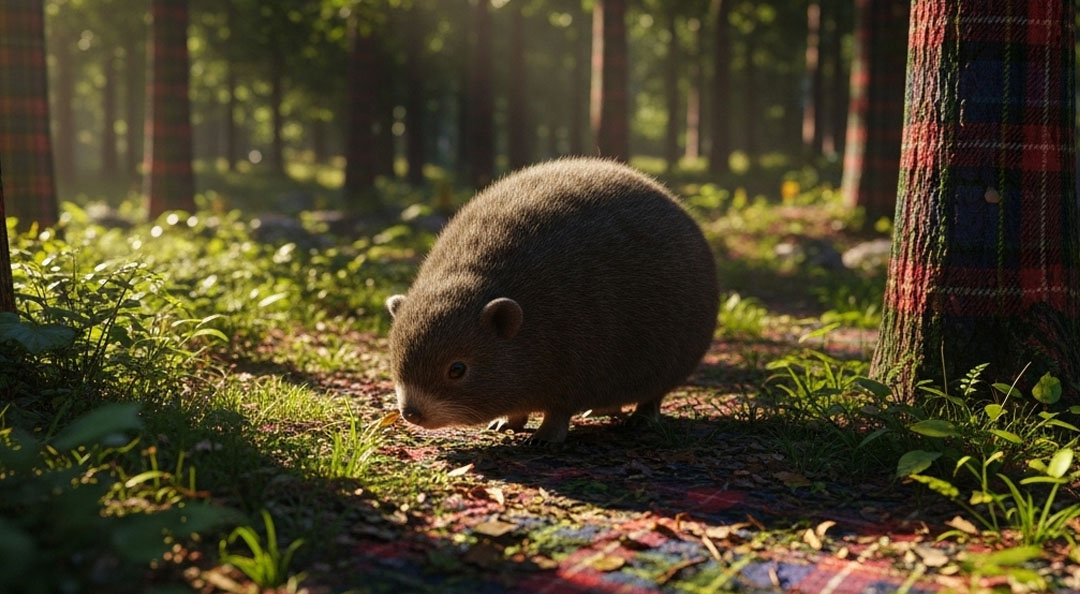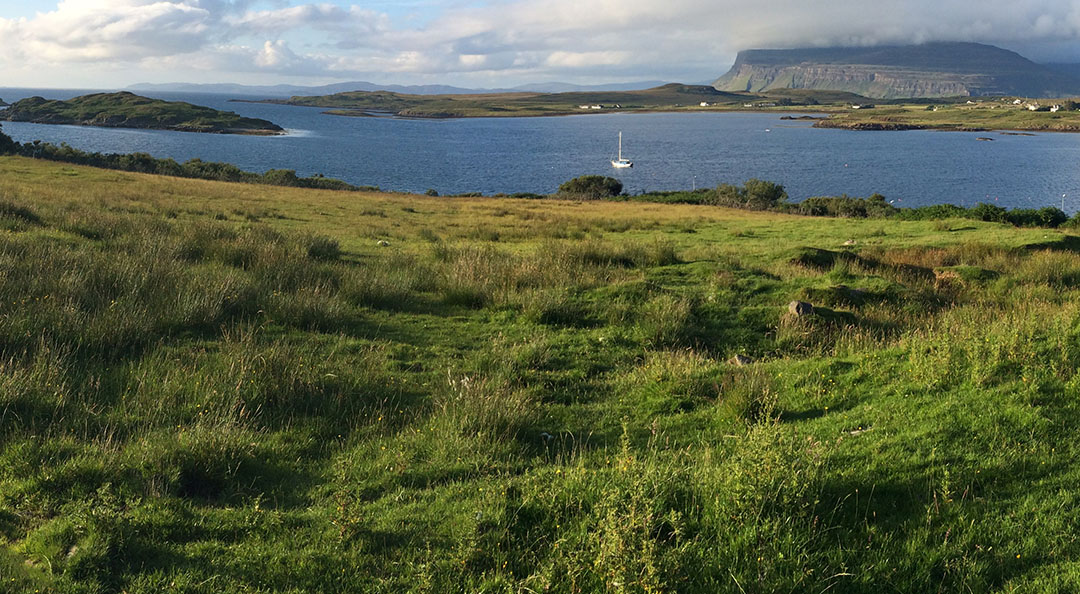The Elusive Mull Highland Haggis: A Guide to Spotting Scotland’s Most Mysterious Creature

The elusive Mull Highland Haggis in its natural habitat
Ah, the Isle of Mull—a breathtaking Scottish gem with rugged coastlines, majestic eagles, and… oh yes, the truly elusive wild haggis. More often consumed than encountered, these minuscule menaces of Scottish folklore are said to roam the Highlands, particularly on islands like Mull. If you’ve ever dreamt of more than just a culinary encounter, join us on a journey to understand, and perhaps even spot, Mull’s most mysterious inhabitant.
“Walking home from the Mish, I saw it. A quick flash of something furry, scuttling across the road by the old wall. Definitely a wild haggis, legs churning like mad, disappeared into the shadows faster than you could say ‘Slàinte mhath!’. Mind you, I’d had a couple of drams, but that didn’t stop me seeing it clear as day.” Fingal Campbell, Salmon Procurer
1. Understanding the Wild Haggis: Habitat & Prime Locales
If you’re truly dedicated to catching a glimpse of the wild Mull haggis, understanding their preferred habitat is paramount. These aren’t creatures of the manicured lawn or the bustling village; they thrive where the wind whispers secrets through the heather and the lochs hold ancient reflections.
The Ideal Haggis Habitat: Wild & Uncompromising
- Steep, Heather-Clad Hillsides: Their famously uneven leg lengths (shorter on one side, allowing them to run efficiently around hillsides) make these their natural domain. The denser the heather, the better, providing both camouflage and a ready snack.
- Peaty Bogs and Mossy Moorland: They are surprisingly adept at navigating the squishy, waterlogged ground, often leaving behind a faint, distinctive bubbling sound (or perhaps that’s just the bog gas, one can never be sure).
- Rocky Outcrops and Ancient Stone Walls: These offer perfect vantage points for surveying their territory and quick bolt-holes for evading overly eager (or overly dram-fueled) enthusiasts. Keep an eye on any small, dark crevices.
- Secluded Glens and Sheltered Corries: Wild haggis are shy by nature, preferring hidden pockets of the landscape away from human disturbance, where the air is still and the midges are thick (a primary food source, some say!).
- The Fabled Tartan Forests: While not widely marked on maps, these are areas of ancient, gnarled trees, often pines or oaks, where the dappled sunlight creates patterns on the forest floor reminiscent of a Scottish tartan. Haggis are said to blend remarkably well here, especially deep within the less-visited woodlands like Ardmore or the secluded parts of Tioran. They offer unparalleled shelter and a sense of mystique.
Prime Mull Haggis Spotting Areas (with a Pinch of Salt)
While a true haggis sighting is, of course, a matter of pure luck and considerable patience (and possibly excellent whisky), certain areas on Mull are more theoretically promising due to their ideal haggis habitat:
- The Slopes of Ben More: Mull’s only Munro offers prime, rugged, high-altitude habitat. The higher you go, the more undisturbed the terrain – and the less likely anyone else is around to scoff at your quest.
- Remote Parts of the Ross of Mull: Beyond the village of Fionnphort, the wilder, less-trodden paths of the Ross Peninsula offer vast expanses of moorland, perfect for the reclusive haggis. Try areas around Loch Scridain’s wilder shores.
- The Coastal Paths North of Dervaig: While the coastline is often breezy (which haggis dislike), pockets of sheltered, rocky ground and hidden inlets might offer refuge. Plus, the views are stunning even if the haggis remain elusive.
- Anywhere the Midges are Thriving: Anecdotal evidence (often shared late at night in island pubs) suggests a strong correlation between abundant midge populations and potential haggis activity. Where there’s a buffet, there’s often a diner!

Domestic haggis Tobermory (circa 1852)
2. Fieldcraft for the Aspiring Haggis Spotter: Tips from the (Un)Experts
So, you know where to look and you’ve heard the whispers. Now for the crucial part: the art of the actual haggis hunt. This requires a unique blend of patience, cunning, and perhaps a touch of delusion.
The Sacred Rules of Haggis Spotting
- Stealth is Paramount (But Don’t Spook the Sheep):
- Move Like a Shadow: Haggis possess an almost supernatural awareness of human presence. Tread lightly, avoid snapping twigs, and try to blend into the scenery. Imagine you’re stalking a very shy, slightly spherical ghost.
- Patience is a Virtue (or a Requirement for Hypothermia): Haggis sightings are rare precisely because they are masters of camouflage and stillness. Be prepared to sit, wait, and perhaps question your life choices for extended periods in damp conditions. A good book (on Scottish folklore, perhaps?) can help pass the time.
- Understand the Wind (and How Haggis Use It):
- Approach Upwind: Haggis have an incredibly acute sense of smell, far surpassing their eyesight (which, admittedly, is tailored for seeing drams from a distance). Always approach from downwind to ensure your scent (of last night’s drams or your desperation) doesn’t carry to their sensitive nostrils.
- Listen for the Whisper: On a still day, a faint ‘skitter-scurry’ might be heard, often mistaken for a particularly nimble vole. That’s your cue!
- Essential Equipment for the Dedicated Hunter:
- Binoculars (for the Optimistic): While most sightings are fleeting blurs, a good pair of binoculars can theoretically help confirm unique leg lengths or shaggy coat patterns from a distance.
- A Sturdy Flask (for the Realistic): Filled with a warming beverage (or a ‘courage enhancer’). Essential for maintaining morale during long, fruitless watches, and potentially for dulling the memory of not seeing a haggis.
- A Camera (for the Delusional): For capturing that once-in-a-lifetime, incredibly blurry, possibly-just-a-sheep photo that will be undeniable proof to exactly no one. Burst mode is highly recommended.
- A Midge Net: Crucial. The midges won’t help you spot a haggis, but the lack of one will ensure you spot nothing but the inside of your own arm as you swat frantically.
- Deciphering the Signs of Haggis Activity:
- Disturbed Heather Patches: Look for flattened areas in the heather where a round, furry creature might have rested, or uneven trails where one has scurried around a hill.
- Peculiar Droppings: While often confused with sheep or deer droppings, true haggis spoor is said to have a faint aroma of oats and spices. (Approach with caution, and perhaps a strong imagination.)
- Unexplained Rustling: Any sudden rustle in dense undergrowth that isn’t accompanied by a bird or a deer should be investigated immediately. It’s probably just a mouse, but you never know…

There are at least 5 haggi hiding in this image. True masters of camouflage.
3. Haggis Behaviour: Deciphering the Wild Ways of the Wee Beastie
Beyond where they hide and how to find them, a truly accomplished haggis spotter must understand the creature’s fundamental behaviours. The wild haggis is a creature of habit, albeit habits that are entirely unique to its mythical existence.
The Peculiar Pace of the Haggis
- The Unidirectional Sprint: As legend (and basic physics, if you squint hard enough) dictates, the wild haggis possesses legs shorter on one side than the other. This remarkable adaptation allows it to run at incredible speeds around hillsides in a constant spiral. This means if you see one running clockwise, it’s a ‘Right-Legged Haggis’ and will inevitably vanish around the hill to your right. A ‘Left-Legged Haggis’ will do the opposite. They rarely run in a straight line, as this would cause them to tumble head-over-heels, a sight both tragic and hilarious.
- The Sudden Vanish: Haggis are masters of rapid disappearance. One moment they’re a blur, the next, they’ve simply… gone. This is attributed to their exceptional camouflage within the heather and their ability to flatten themselves against the terrain, becoming indistinguishable from a particularly mossy rock or a forgotten picnic blanket.
The Voice of the Wild
- The Elusive Grunt: Authentic haggis calls are exceedingly rare. Most often, they communicate through a series of low, rumbling grunts, easily mistaken for indigestion or the distant bleating of a sheep.
- The Skitter-Scurry: Their most common audible signature is the rapid ‘skitter-scurry’ sound as they navigate rocky or heathery terrain. It’s the sound of pure, unadulterated haggis velocity.
- The Whistle-Squeak (Myth or Reality?): Some claim to have heard a high-pitched whistle, almost like a tiny teapot, thought to be a distress call or a warning. However, these reports almost exclusively come from those who have spent a considerable amount of time ‘hydrating’ at local establishments.
Diet and Domesticity (or Lack Thereof)
- Heather & Herbs: The primary diet of the wild haggis consists of heather, bog cotton, and various wild herbs found on the moors. This contributes to their famously robust flavour, should one ever, hypothetically, come into contact with one in a culinary context.
- A Taste for the Finer Things? There are persistent whispers that wild haggis are partial to a stray crumb of shortbread or, even more controversially, a dropped dram of whisky. While scientific proof is lacking, many a whisky enthusiast has reported a missing drop or two after an outdoor tasting session.

Slàinte mhath
4. The Ethical Haggis Enthusiast: Responsible Spotting in the Wild
Congratulations! By now, you’re either well on your way to becoming a dedicated haggis spotter or you’re simply enjoying a very long, very scenic walk. Either way, it’s crucial to practice responsible haggis tourism. These are wild creatures (in the most wild sense of the word), and their continued elusive existence depends on our respect.
The Haggis Code: Do’s and Don’ts
- Observe from a Distance (Preferably Through Binoculars):
- Do not approach or chase a wild haggis. They are notoriously shy and can be surprisingly quick when startled, especially downhill.
- Remember, a disturbed haggis is a lost haggis. They will vanish and may not reappear for centuries.
- Leave No Trace (Especially of Your Haggis Bait):
- This is fundamental. Do not leave behind food, litter, or half-empty whisky bottles. While a dram might attract one, it’s bad for their mythical digestive systems and the actual environment.
- Take only photographs (preferably blurry ones), leave only footprints (preferably light ones).
- No Trapping or Hunting (Seriously, It’s Illegal and Impossible):
- The wild haggis is a protected species (by the laws of common sense and physics). Any attempt to capture one for culinary purposes is not only futile but deeply frowned upon by the local community and the spirit of Scotland itself.
- Leave your nets, snares, and enormous spoons at home.
- Report Your Sightings (To the Nearest Pub):
- If you genuinely believe you’ve seen a wild haggis, the proper protocol is to calmly proceed to the nearest open pub. Over a pint (or a dram, naturally), recount your tale. The level of enthusiastic nodding from locals will be your true barometer of success. Scientific bodies are, regrettably, less receptive.
- Resist the urge to call emergency services. They have enough on their plate with lost tourists and actual sheep.
A Final Thought: Respect the Myth
The wild haggis is more than just a creature; it’s a testament to Scotland’s enduring sense of humour, its rich folklore, and the boundless imagination of those who brave its rugged landscapes. By respecting their “wild” nature and the spirit of the legend, you contribute to the ongoing mystique of the Isle of Mull’s most extraordinary (and non-existent) inhabitant.

Haggis roaming free in the glens.
“Walking home after a particularly long day’s work, just enjoying the quiet evening, I saw it. A rapid movement, a blur of shaggy fur, scuttling across the path right ahead of me. Its tiny legs were a whirl, propelled with an astonishing speed, and then it was gone, swallowed by the deepening twilight. No mistake, that was a wild haggis. An extraordinary sight to round off the day.” Hamish MacTavish, Chief Whisky Taster, Tobermory Distillery
